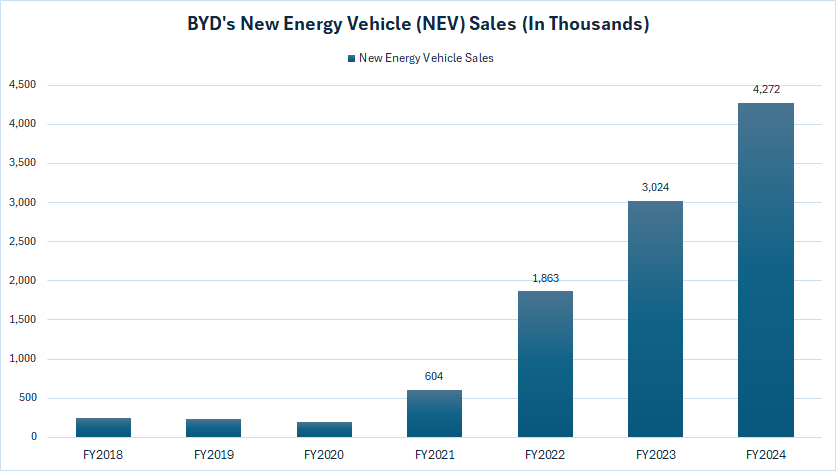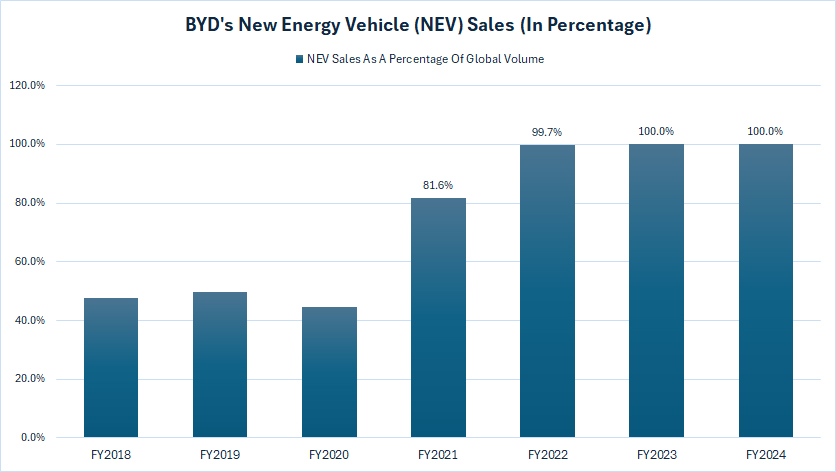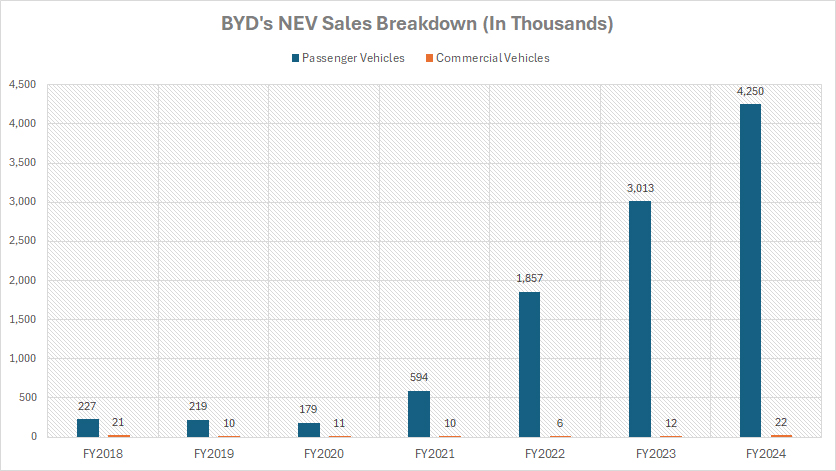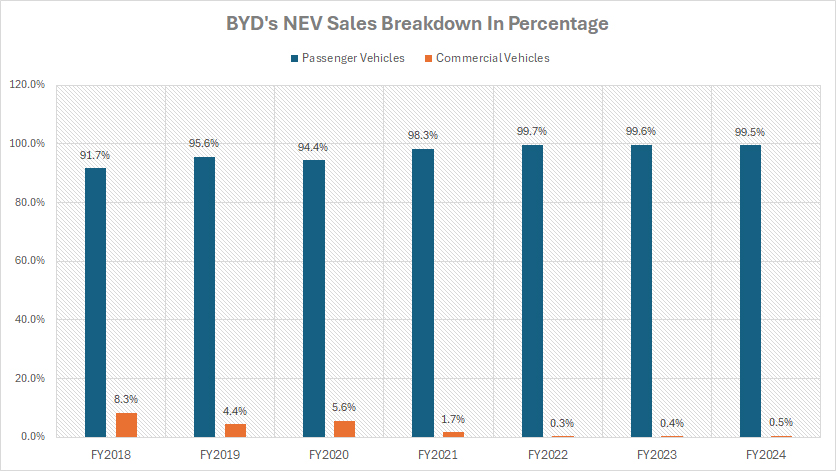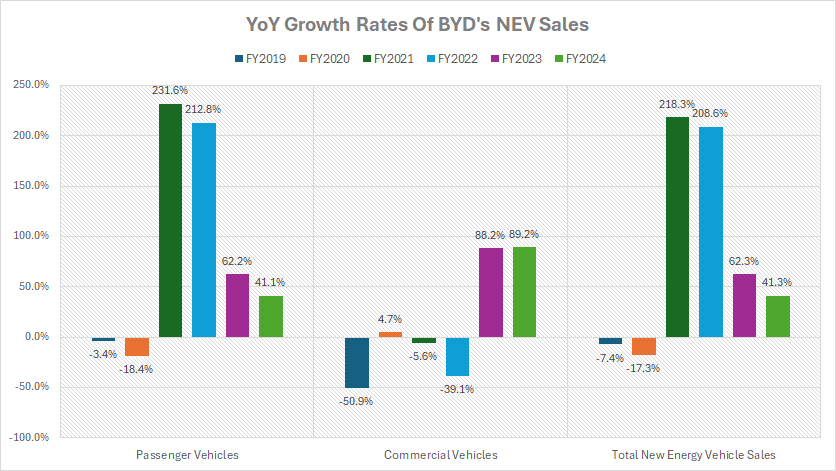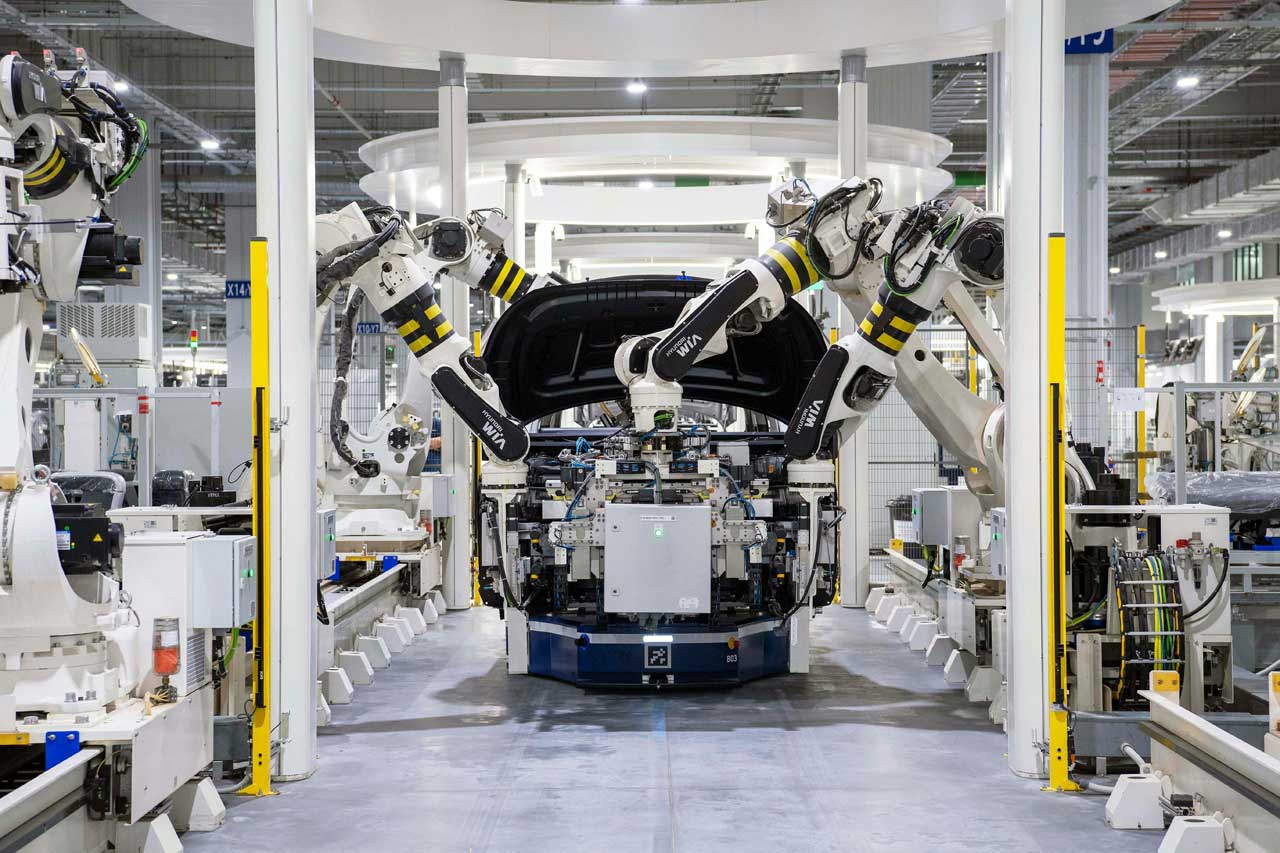
Automotive factory. Pexels Image.
BYD has risen to become one of the top 10 global automakers, achieving over 4 million units in global sales in 2024.
The company has been actively expanding its footprint in significant overseas markets such as Thailand, Turkey, Hungary, and Mexico. Among its lineup, the Seagull, a budget-friendly car model, is available for under $15,000.
This article delves into the sales volume of BYD’s new energy vehicles (NEVs). Let’s dive in and explore the details!
Investors interested in BYD’s other statistics may find more resources on these pages:
Please use the table of contents to navigate this page.
Table Of Contents
Definitions And Overview
Consolidated NEV Sales
A1. New Energy Vehicle (NEV) Sales
A2. NEV Sales As A Percentage Of Global Volume
NEV Sales By Category
B1. Passenger Vehicle And Commercial Vehicle Sales
B2. Percentage Of Passenger Vehicle And Commercial Vehicle Sales To Total NEV Volume
Growth Rates
C1. Growth Rates Of NEV, Passenger Vehicle, And Commercial Vehicle Sales
Conclusion And Reference
S1. Conclusion
S2. References and Credits
S3. Disclosure
Definitions
To help readers understand the content better, the following terms and glossaries have been provided.
New Energy Vehicle (NEV): BYD’s new energy vehicles (NEVs) refer to automobiles that are powered by electric energy, either fully or predominantly. This category includes several types of vehicles:
- Battery Electric Vehicles (BEVs): These vehicles are powered entirely by electricity stored in batteries and do not use any internal combustion engines.
- Plug-in Hybrid Electric Vehicles (PHEVs): These vehicles combine an internal combustion engine with an electric motor, which can be charged from an external power source.
- Fuel Cell Electric Vehicles (FCEVs): These vehicles generate electricity through a chemical reaction between hydrogen and oxygen, producing only water vapor as a byproduct.
BYD is a leading manufacturer of NEVs, known for its innovation in battery technology, electric motors, and electronic controls. The company has a diverse product portfolio, including electric buses, trucks, vans, and passenger cars.
Passenger Vehicle: BYD’s passenger vehicles encompass a diverse range of electric and hybrid models designed to cater to various market segments. Here are some key highlights:
-
Electric Vehicles (EVs):
- BYD Seal: A sleek sedan known for its performance and range3. It features advanced battery technology and a luxurious interior.
- BYD Dolphin: A compact and stylish EV, perfect for urban driving.
- BYD M6: A spacious 7-seater SUV with a long range and premium features.
- BYD Seagull: The BYD Seagull is a 5-door hatchback and affordable electric vehicle designed to cater to urban drivers.
-
Plug-in Hybrid Electric Vehicles (PHEVs):
- BYD Seal DM-i: Combines an internal combustion engine with an electric motor, offering flexibility and efficiency.
Commercial Vehicle: BYD’s commercial vehicles include a range of electric trucks and vans designed to meet the needs of various industries. Here are some key highlights:
-
Electric Trucks:
- ETP3: A versatile electric truck suitable for logistics and construction.
- ETM6: A powerful electric truck designed for demanding operational requirements.
- ETH8: A robust electric truck for vocational sectors such as sanitation, warehousing, and airports.
-
Electric Vans:
- BYD T3: A compact electric van ideal for urban delivery and logistics. It features a spacious cargo area and efficient battery technology.
New Energy Vehicle (NEV) Sales
byd-total-sales-of-nev
(click image to expand)
The definition of BYD’s new energy vehicle is available here: New Energy Vehicle (NEV).
In fiscal year 2024, BYD delivered an impressive 4.3 million new energy vehicles (NEVs), marking a significant 41% increase compared to the 3.0 million units sold in fiscal year 2023. In fiscal year 2022, BYD’s NEV sales reached 1.9 million units, showcasing the company’s consistent growth in the electric vehicle market.
Historically, from fiscal year 2018 to 2020, BYD’s sales of new energy vehicles were relatively modest, with less than 500,000 vehicles sold per year. The dramatic increase in recent years highlights BYD’s rapid expansion and growing dominance in the NEV sector.
BYD’s substantial growth can be attributed to several factors, including increased consumer demand for environmentally friendly vehicles, advancements in battery technology, and strategic expansions into key overseas markets such as Thailand, Turkey, Hungary, and Mexico. Additionally, the introduction of affordable models like the Seagull, priced under $15,000, has made electric vehicles more accessible to a broader audience.
BYD’s impressive sales performance in the new energy vehicle market underscores its commitment to innovation and sustainability, positioning the company as a leading player in the global automotive industry.
NEV Sales As A Percentage Of Global Volume
byd-total-sales-of-nev-in-percentage
(click image to expand)
The definition of BYD’s new energy vehicle is available here: New Energy Vehicle (NEV).
With respect to the global volume, BYD’s new energy vehicle (NEV) sales in fiscal year 2024 accounted for 100% of the automaker’s worldwide volume. This means that BYD’s entire vehicle sales were composed solely of new energy vehicles, marking a complete phase-out of fossil-fueled vehicle sales.
A similar trend was observed in fiscal year 2023, where new energy vehicle sales also represented the entirety of BYD’s global sales. In fiscal year 2022, BYD’s NEV sales constituted 99.7% of the worldwide volume, demonstrating a near-total shift to electric and hybrid vehicles. In fiscal year 2021, NEVs made up 81.6% of BYD’s global sales volume.
Looking back, from fiscal years 2018 to 2020, BYD’s sales of new energy vehicles represented less than 50% of the automaker’s global volume. During this period, the majority of BYD’s sales were still composed of fossil-fueled vehicles.
This dramatic shift toward new energy vehicles reflects BYD’s strategic focus on sustainability and innovation in the automotive industry. The company’s successful transition to an all-NEV lineup highlights its commitment to reducing carbon emissions and promoting environmentally friendly transportation solutions.
BYD’s ability to phase out fossil-fueled vehicles entirely and achieve a 100% NEV sales volume is a testament to its leadership in the electric vehicle market. This transformation also underscores the growing consumer demand for electric and hybrid vehicles, driven by increasing environmental awareness and supportive government policies.
BYD’s journey from a mixed fleet of fossil-fueled and new energy vehicles to a complete focus on NEVs demonstrates its dedication to driving the future of transportation. This strategic pivot has positioned BYD as a leading player in the global automotive industry, setting a precedent for other automakers to follow.
Passenger Vehicle And Commercial Vehicle Sales
byd-nev-sales-breakdown
(click image to expand)
BYD’s new energy vehicle (NEV) sales are comprised of two main categories: passenger vehicles and commercial vehicles. The definitions of BYD’s passenger and commercial vehicles are available here: passenger vehicle and commercial vehicle.
BYD’s passenger vehicles represent the vast majority of the automaker’s NEV (new energy vehicle) segment sales, as illustrated in the chart above. In fiscal year 2024, BYD’s sales of passenger vehicles reached over 4.3 million units, while sales of commercial vehicles were just 22,000 units. This reflects a 41% increase in passenger vehicle volume from the 3.0 million units sold in 2023.
In fiscal year 2022, BYD delivered 1.9 million passenger vehicles, and the figure was only 600,000 units in 2021. From fiscal years 2018 to 2020, BYD sold fewer than 500,000 passenger vehicles annually, indicating a dramatic growth trajectory in recent years.
In contrast, BYD’s sales of commercial vehicles have been considerably smaller. On average, BYD delivered just 13,000 commercial vehicles between fiscal years 2022 and 2024, while the sales of passenger vehicles averaged 3 million units during the same period. This stark difference highlights the dominance of passenger vehicles in BYD’s overall NEV sales.
The significant growth in passenger vehicle sales underscores BYD’s successful expansion in the global electric vehicle market. The company’s strategic focus on affordable and innovative models, such as the Seagull priced under $15,000, has made electric vehicles more accessible to a broader audience, driving up sales volumes.
BYD’s emphasis on passenger vehicles has been a key factor in its rapid growth and increasing market share in the NEV segment.
Percentage Of Passenger Vehicle And Commercial Vehicle Sales To Total NEV Volume
byd-nev-sales-breakdown-in-percentage
(click image to expand)
BYD’s new energy vehicle (NEV) sales are comprised of two main categories: passenger vehicles and commercial vehicles. The definitions of BYD’s passenger and commercial vehicles are available here: passenger vehicle and commercial vehicle.
BYD’s sales percentage of passenger vehicles has seen a remarkable increase, rising from 91.7% in fiscal year 2018 to an impressive 99.5% by fiscal year 2024, as illustrated in the chart above. This surge highlights the growing dominance of passenger vehicles within BYD’s overall new energy vehicle (NEV) sales.
On the flipped side, the sales percentage of BYD’s commercial vehicles has experienced a significant decline. In fiscal year 2018, commercial vehicles accounted for 8.3% of BYD’s NEV sales, but this figure has plummeted to just 0.5% by fiscal year 2024. This trend indicates a diminishing role of commercial vehicles in BYD’s NEV segment.
Historically, from fiscal years 2018 to 2020, passenger vehicles already constituted the majority of BYD’s NEV sales, albeit at lower percentages compared to recent years. During this period, the company was still transitioning and expanding its NEV portfolio.
This shift towards a higher percentage of passenger vehicle sales reflects BYD’s strategic focus on producing affordable and innovative passenger models that cater to a broad audience. The introduction of budget-friendly models, like the Seagull priced under $15,000, has played a crucial role in driving up passenger vehicle sales.
BYD’s emphasis on passenger vehicles has not only bolstered its NEV sales volume but also reinforced its position as a leading player in the global electric vehicle market. The declining significance of commercial vehicles within BYD’s NEV segment further underscores the company’s strategic pivot towards passenger vehicles to meet growing consumer demand and capitalize on market opportunities.
Growth Rates Of NEV, Passenger Vehicle, And Commercial Vehicle Sales
byd-nev-sales-growth-rates
(click image to expand)
BYD’s new energy vehicle (NEV) sales are comprised of two main categories: passenger vehicles and commercial vehicles. The definitions of BYD’s NEV, passenger and commercial vehicles are available here: NEV, passenger vehicle, and commercial vehicle.
The impressive growth of BYD’s new energy vehicle (NEV) sales is driven almost entirely by its passenger vehicles, as depicted in the chart above. This trend highlights the dominant role that passenger vehicles play in the company’s overall sales performance.
On average, BYD’s sales of passenger vehicles have experienced a remarkable 105% annual growth rate between fiscal years 2022 and 2024. In contrast, the average annual growth rate for commercial vehicles during the same period was a more modest 46%. This significant difference underscores the rapid expansion and consumer demand for BYD’s passenger vehicles.
Cumulatively, BYD’s total NEV sales have grown at an impressive average annual rate of 104% from fiscal years 2022 to 2024. This substantial increase reflects the company’s successful strategies in expanding its NEV portfolio, meeting market demand, and capitalizing on the growing popularity of electric vehicles.
The introduction of innovative and affordable passenger models, such as the Seagull priced under $15,000, has played a crucial role in driving BYD’s sales growth. Additionally, BYD’s strategic expansion into key overseas markets, including Thailand, Turkey, Hungary, and Mexico, has further contributed to its robust performance.
BYD’s focus on passenger vehicles has been the primary driver behind its impressive NEV sales growth, positioning the company as a leading player in the global automotive industry. This growth trajectory is a testament to BYD’s commitment to innovation, sustainability, and meeting the evolving needs of consumers.
Conclusion
BYD’s remarkable growth in new energy vehicle sales is driven primarily by its passenger vehicle segment. The company’s strategic focus on producing affordable and innovative passenger models, such as the Seagull priced under $15,000, has significantly contributed to its sales volume surge. Additionally, BYD’s expansion into key overseas markets like Thailand, Turkey, Hungary, and Mexico has bolstered its global presence and market share.
The shift towards a higher percentage of passenger vehicle sales, coupled with the declining significance of commercial vehicles, highlights BYD’s success in capturing consumer demand for electric and hybrid vehicles. This strategic emphasis on passenger vehicles has allowed BYD to achieve impressive growth rates and solidify its position as a leading player in the global NEV market.
Overall, BYD’s commitment to innovation, sustainability, and meeting the evolving needs of consumers has driven its remarkable performance in the NEV segment. The company’s ability to phase out fossil-fueled vehicles entirely and focus on new energy vehicles underscores its dedication to shaping the future of transportation and promoting environmentally friendly solutions.
References and Credits
1. All financial figures presented were obtained and referenced from BYD’s monthly production and sales reports published on the company’s investor relations page: BYD Latest Announcement.
2. Pexels Images.
Disclosure
We may use the assistance of artificial intelligence (AI) tools to produce some of the text in this article. However, the data is directly obtained from original sources and meticulously cross-checked by our editors multiple times to ensure its accuracy and reliability.
If you find the information in this article helpful, please consider sharing it on social media. Additionally, providing a link back to this article from any website can help us create more content like this in the future.
Thank you for your support and engagement! Your involvement helps us continue to provide high-quality, reliable content.

